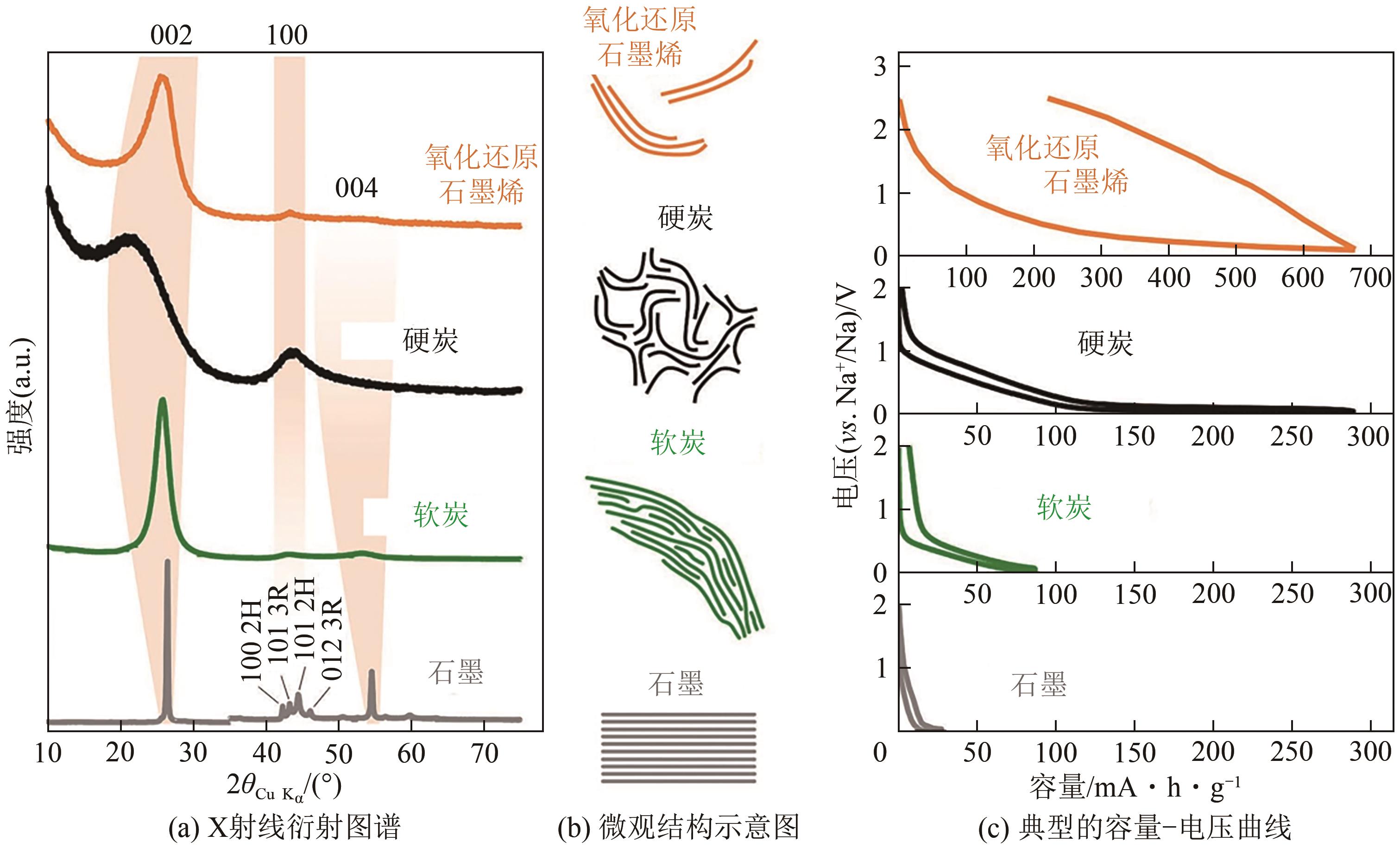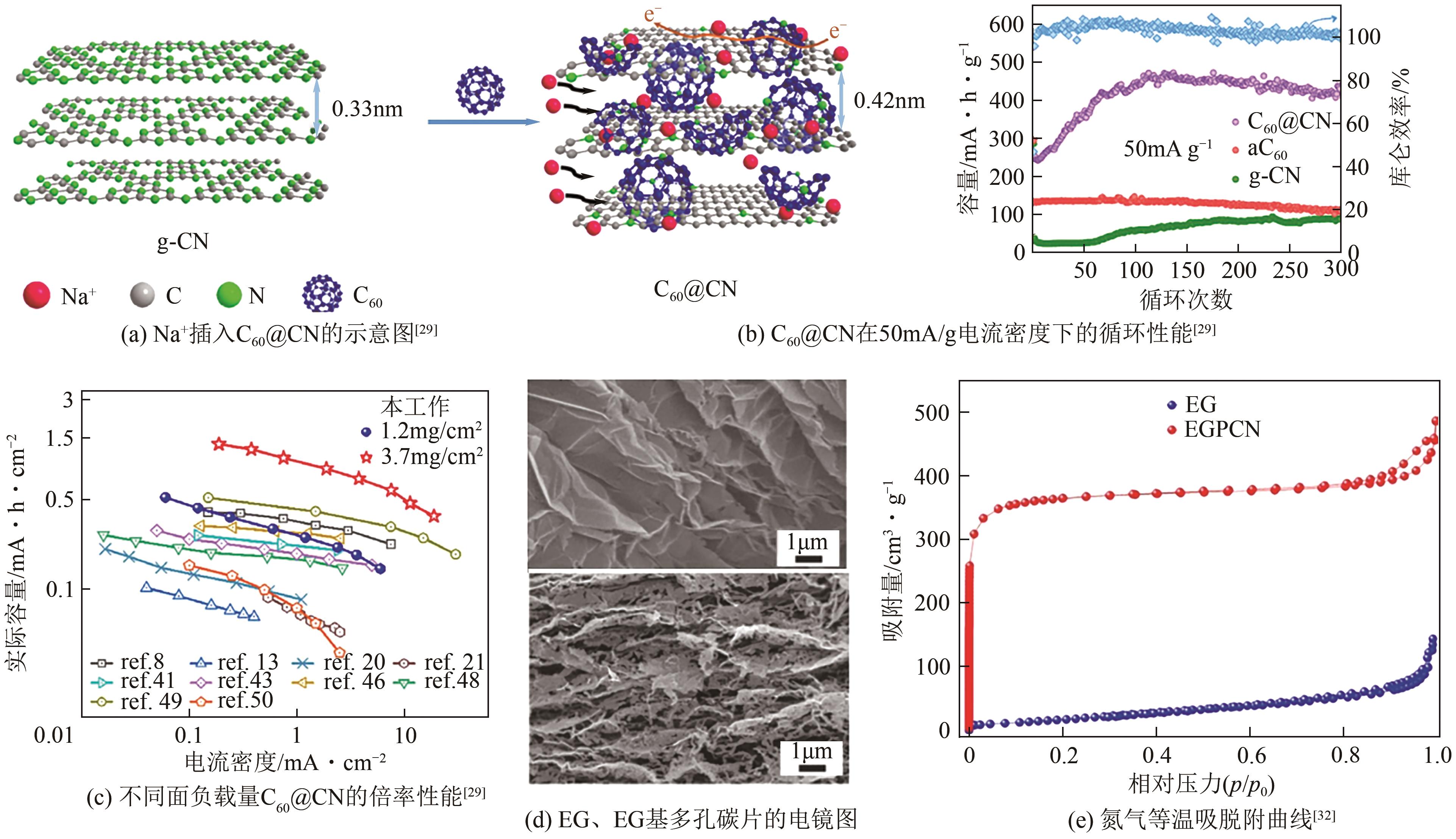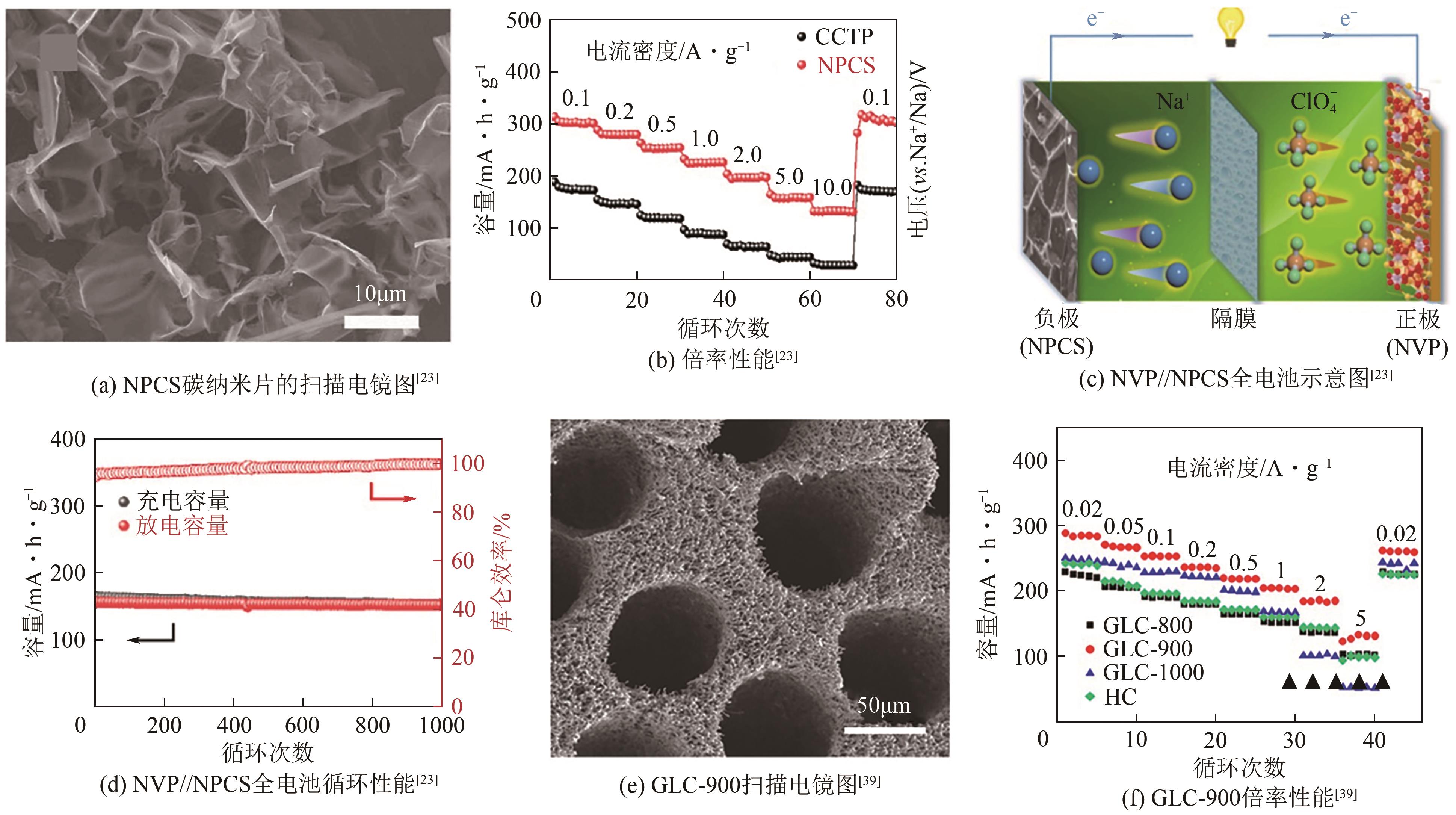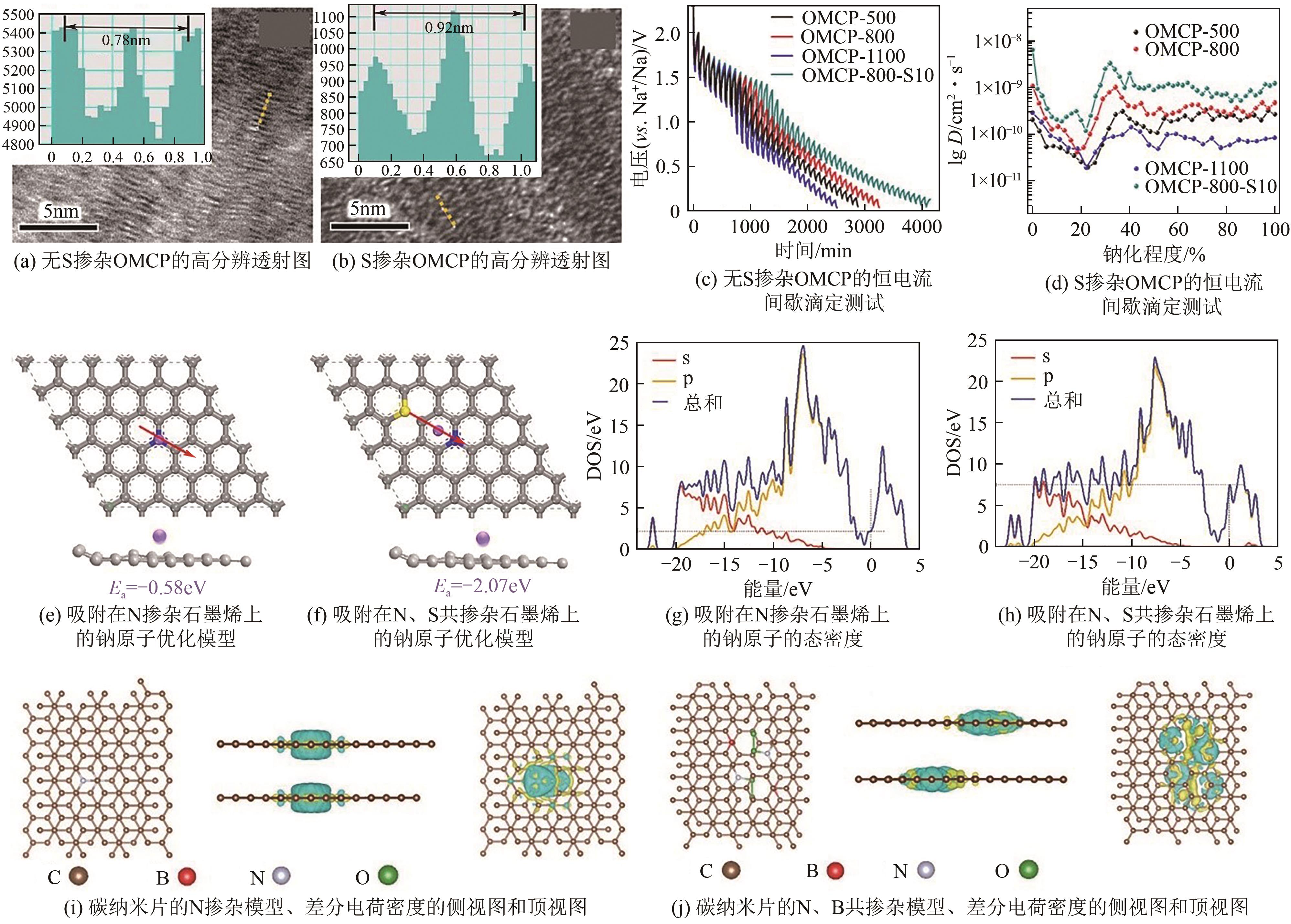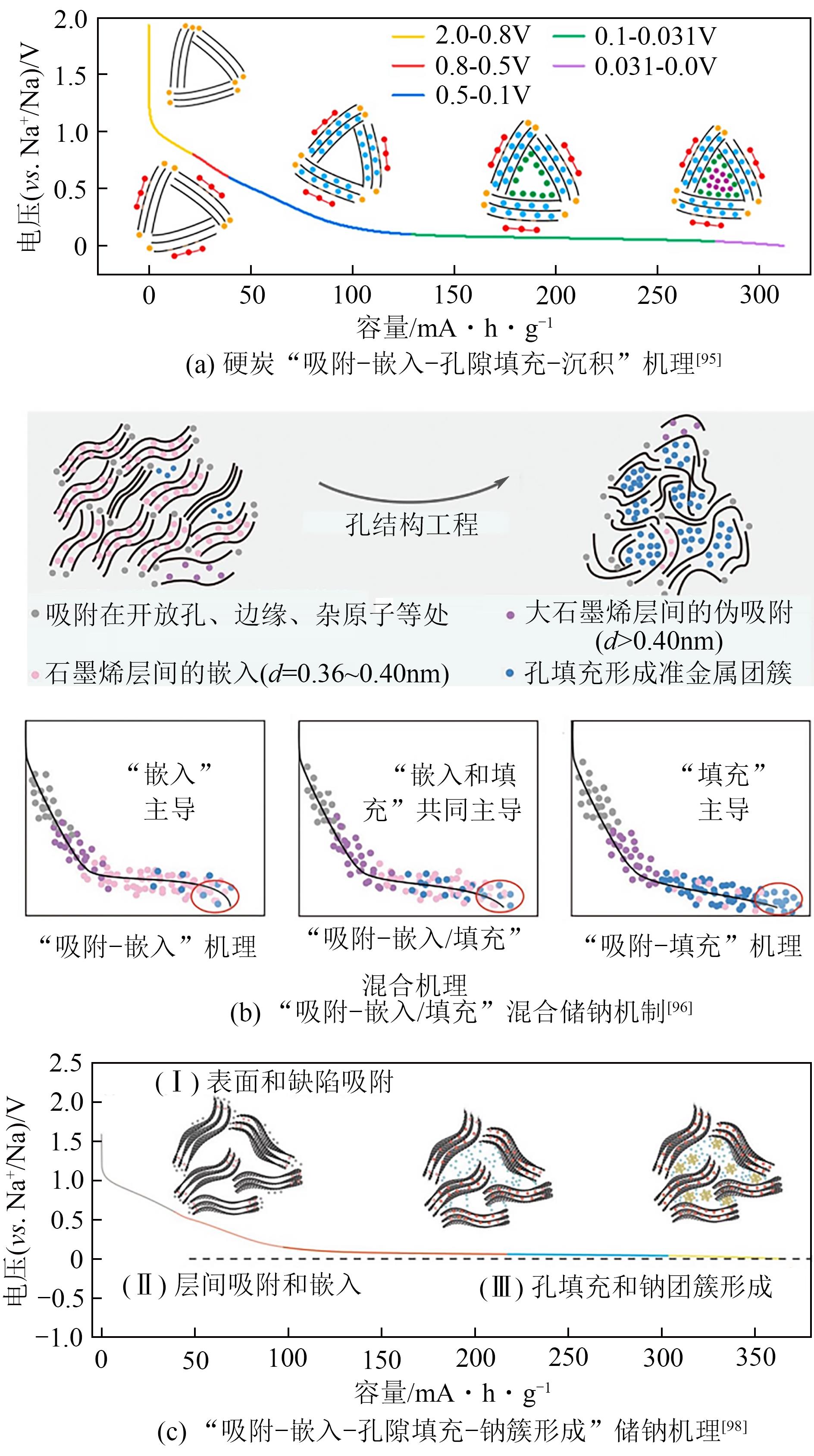化工进展 ›› 2024, Vol. 43 ›› Issue (10): 5581-5600.DOI: 10.16085/j.issn.1000-6613.2023-1660
• 材料科学与技术 • 上一篇
炭材料在储钠器件负极中的研究进展
- 1.西安交通大学环境科学与工程系,陕西 西安 710049
2.云南云天化股份有限公司,云南 昆明 650228
-
收稿日期:2023-09-19修回日期:2024-02-18出版日期:2024-10-15发布日期:2024-10-29 -
通讯作者:王玲,延卫 -
作者简介:宗世荣(1987—),男,博士研究生,工程师,研究方向为钠离子电池和钠离子电容器。E-mail:531792154@qq.com。 -
基金资助:国家自然科学基金(52102112);中央高校基本科研业务费(xzy012022072);中国博士后科学基金(2020M683468)
Research progress of carbon as anode materials for sodium-ion storage devices
ZONG Shirong1,2( ), WANG Ling1(
), WANG Ling1( ), YAO Qiuyue1, YAN Wei1(
), YAO Qiuyue1, YAN Wei1( )
)
- 1.Department of Environmental Science and Engineering, Xi'an Jiaotong University, Xi'an 710049, Shaanxi, China
2.Yunnan Yuntianhua Co. , Ltd. , Kunming 650228, Yunnan, China
-
Received:2023-09-19Revised:2024-02-18Online:2024-10-15Published:2024-10-29 -
Contact:WANG Ling, YAN Wei
摘要:
在众多的储能器件中,储钠器件凭借钠的资源丰富、价格低廉等优势,非常有希望应用于新一代电化学储能体系。由于电极材料对储能器件的电化学性能至关重要,因此开发性能优异、价格低廉的负极材料来进一步提高储钠器件的电化学性能对其大规模应用具有重要意义。在各种负极材料中,炭材料凭借其独特的结构而具有优异的循环稳定性与倍率性能,有望成为最具潜力商业化的储钠器件负极材料。本文介绍了石墨、无定形炭等目前研究较为广泛的几类炭材料,提出了各个材料的优点、存在的问题及改性方法,总结了近年来炭材料在钠离子电池和钠离子电容器这两类主要的储钠器件的研究进展以及炭材料的储钠机制,最后提出了炭材料在储钠器件领域遇到的问题和挑战,并对其发展前景进行了展望。
中图分类号:
引用本文
宗世荣, 王玲, 姚秋月, 延卫. 炭材料在储钠器件负极中的研究进展[J]. 化工进展, 2024, 43(10): 5581-5600.
ZONG Shirong, WANG Ling, YAO Qiuyue, YAN Wei. Research progress of carbon as anode materials for sodium-ion storage devices[J]. Chemical Industry and Engineering Progress, 2024, 43(10): 5581-5600.
| 炭材料 | ICE/% | 循环性能 | 倍率性能/mA·h·g-1 | 参考文献 |
|---|---|---|---|---|
| PGC | — | 0.1A/g循环250次后237mA·h/g | 72(2A/g) | [ |
| C60@CN | 44 | 5A/g循环5000次后101.2mA·h/g | 226.6(1A/g) | [ |
| 6H-G4 | 43 | 0.1A/g循环200次后容量保持率87% | 66(1A/g) | [ |
| FGC | — | 1A/g循环10000次后容量保持率87% | 106(10A/g) | [ |
| EG基碳纳米片 | 21.3 | 0.1A/g下198mA·h/g | 65(5A/g) | [ |
| IWC(1000℃) | 22.1 | 0.1A/g循环100次后217mA·h/g | 101(1A/g) | [ |
| NPSC | 35.45 | 1A/g循环3000次后162mA·h/g | 130(5A/g) | [ |
| NPCS | 61.2 | 5A/g循环10000次后容量保持率93.7% | 131.5(10A/g) | [ |
| NC(1200℃) | 49.5 | 0.1A/g循环500次后容量保持率87% | 85(0.5A/g) | [ |
| 硬炭微纤维(1400℃) | 69 | 0.06A/g循环100次后200.6mA·h/g(93%) | 159.7(0.15A/g) | [ |
| PFBC(700℃) | 39.4 | 0.2C循环300次后322mA·h/g | 183(5C) | [ |
| GLC(900℃) | 73 | 5A/g循环1500次后容量保持率近100% | 124(5A/g) | [ |
| 榛子壳硬炭 | 91 | 20mA/g循环100次后306mA·h/g(91%) | — | [ |
| 樟木渣硬炭(0.25℃/min) | 82.4 | 50mA/g循环200次后容量保持率90% | 67.4(0.4A/g) | [ |
| SHCs(1500℃) | 90.5 | 0.4C循环300次后容量保持率94.5% | — | [ |
| HCNS(1500℃) | 88 | 0.5A/g循环100次后240mA·h/g | 79(1A/g) | [ |
| PTA-Lys-800 | 51.3 | 0.1A/g循环100次后338.8mA·h/g(86%) | 131.1(4A/g) | [ |
| 介孔N掺杂棕榈叶硬炭 | — | 0.2A/g循环1000次后231mA·h/g(约95%) | 120(1A/g) | [ |
| N掺杂三维多孔碳纳米片 | 约13 | 1A/g循环1200次后400mA·h/g | 106(50A/g) | [ |
| S-CNS | 约58 | 5A/g循环2000次后容量保持率94% | 133(10A/g) | [ |
| OMCP(800℃) | — | 60mA/g循环200次后191.9mA·h/g | 266.7(0.6A/g) | [ |
| PC | 63.9 | 0.1A/g循环200次后310.4mA·h/g | 226.2(2A/g) | [ |
| P功能化硬炭 | 约60 | 20mA/g循环次100后386.4mA·h/g(98.2%) | 79.9(2A/g) | [ |
| NSPC | 72.3 | 10A/g循环700次后239.4mA·h/g | 233.3(10A/g) | [ |
| NSC(800℃) | 58.37 | 0.2A/g循环100次后316.1mA·h/g | 178.3(3A/g) | [ |
| S-NCNFs | 32.6 | 0.05A/g循环100次后336.2mA·h/g | 132(10A/g) | [ |
| N、S共掺杂空心碳纳米片 | 51.3 | 5A/g循环5000次后339mA·h/g | 245(60A/g) | [ |
| NPHC | 71 | 1A/g循环2000次后183mA·h/g | 144(10A/g) | [ |
| N/P-HCNF | — | 1A/g循环5000次后容量保持率95% | 100(10A/g) | [ |
| NPPC | 42.8 | 0.1A/g循环100次后311.2mA·h/g | 102.8(10A/g) | [ |
| N、B共掺杂碳纳米片 | — | 0.2A/g循环200次后309mA·h/g | 192(10A/g) | [ |
表1 炭材料的储钠性能
| 炭材料 | ICE/% | 循环性能 | 倍率性能/mA·h·g-1 | 参考文献 |
|---|---|---|---|---|
| PGC | — | 0.1A/g循环250次后237mA·h/g | 72(2A/g) | [ |
| C60@CN | 44 | 5A/g循环5000次后101.2mA·h/g | 226.6(1A/g) | [ |
| 6H-G4 | 43 | 0.1A/g循环200次后容量保持率87% | 66(1A/g) | [ |
| FGC | — | 1A/g循环10000次后容量保持率87% | 106(10A/g) | [ |
| EG基碳纳米片 | 21.3 | 0.1A/g下198mA·h/g | 65(5A/g) | [ |
| IWC(1000℃) | 22.1 | 0.1A/g循环100次后217mA·h/g | 101(1A/g) | [ |
| NPSC | 35.45 | 1A/g循环3000次后162mA·h/g | 130(5A/g) | [ |
| NPCS | 61.2 | 5A/g循环10000次后容量保持率93.7% | 131.5(10A/g) | [ |
| NC(1200℃) | 49.5 | 0.1A/g循环500次后容量保持率87% | 85(0.5A/g) | [ |
| 硬炭微纤维(1400℃) | 69 | 0.06A/g循环100次后200.6mA·h/g(93%) | 159.7(0.15A/g) | [ |
| PFBC(700℃) | 39.4 | 0.2C循环300次后322mA·h/g | 183(5C) | [ |
| GLC(900℃) | 73 | 5A/g循环1500次后容量保持率近100% | 124(5A/g) | [ |
| 榛子壳硬炭 | 91 | 20mA/g循环100次后306mA·h/g(91%) | — | [ |
| 樟木渣硬炭(0.25℃/min) | 82.4 | 50mA/g循环200次后容量保持率90% | 67.4(0.4A/g) | [ |
| SHCs(1500℃) | 90.5 | 0.4C循环300次后容量保持率94.5% | — | [ |
| HCNS(1500℃) | 88 | 0.5A/g循环100次后240mA·h/g | 79(1A/g) | [ |
| PTA-Lys-800 | 51.3 | 0.1A/g循环100次后338.8mA·h/g(86%) | 131.1(4A/g) | [ |
| 介孔N掺杂棕榈叶硬炭 | — | 0.2A/g循环1000次后231mA·h/g(约95%) | 120(1A/g) | [ |
| N掺杂三维多孔碳纳米片 | 约13 | 1A/g循环1200次后400mA·h/g | 106(50A/g) | [ |
| S-CNS | 约58 | 5A/g循环2000次后容量保持率94% | 133(10A/g) | [ |
| OMCP(800℃) | — | 60mA/g循环200次后191.9mA·h/g | 266.7(0.6A/g) | [ |
| PC | 63.9 | 0.1A/g循环200次后310.4mA·h/g | 226.2(2A/g) | [ |
| P功能化硬炭 | 约60 | 20mA/g循环次100后386.4mA·h/g(98.2%) | 79.9(2A/g) | [ |
| NSPC | 72.3 | 10A/g循环700次后239.4mA·h/g | 233.3(10A/g) | [ |
| NSC(800℃) | 58.37 | 0.2A/g循环100次后316.1mA·h/g | 178.3(3A/g) | [ |
| S-NCNFs | 32.6 | 0.05A/g循环100次后336.2mA·h/g | 132(10A/g) | [ |
| N、S共掺杂空心碳纳米片 | 51.3 | 5A/g循环5000次后339mA·h/g | 245(60A/g) | [ |
| NPHC | 71 | 1A/g循环2000次后183mA·h/g | 144(10A/g) | [ |
| N/P-HCNF | — | 1A/g循环5000次后容量保持率95% | 100(10A/g) | [ |
| NPPC | 42.8 | 0.1A/g循环100次后311.2mA·h/g | 102.8(10A/g) | [ |
| N、B共掺杂碳纳米片 | — | 0.2A/g循环200次后309mA·h/g | 192(10A/g) | [ |
| 1 | HUANG Si, QIU Xueqing, WANG Caiwei, et al. Biomass-derived carbon anodes for sodium-ion batteries[J]. New Carbon Materials, 2023, 38(1): 40-66. |
| 2 | ZHAO Lingfei, HU Zhe, LAI Weihong, et al. Hard carbon anodes: Fundamental understanding and commercial perspectives for Na-ion batteries beyond Li-ion and K-ion counterparts[J]. Advanced Energy Materials, 2021, 11(1): 2002704. |
| 3 | 苑雪, 李洪基, 白文慧, 等. 生物质衍生炭基材料在钠离子电池负极中的应用[J]. 储能科学与技术, 2023, 12(3): 721-742. |
| YUAN Xue, LI Hongji, BAI Wenhui, et al. Application of biomass-derived carbon-based anode materials in sodium ion battery[J]. Energy Storage Science and Technology, 2023, 12(3): 721-742. | |
| 4 | WU Feixiang, MAIER Joachim, YU Yan. Guidelines and trends for next-generation rechargeable lithium and lithium-ion batteries[J]. Chemical Society Reviews, 2020, 49(5): 1569-1614. |
| 5 | ZHENG Yun, YAO Yuze, Jiahua OU, et al. A review of composite solid-state electrolytes for lithium batteries: Fundamentals, key materials and advanced structures[J]. Chemical Society Reviews, 2020, 49(23): 8790-8839. |
| 6 | CAO Yanxiu, MAJEED Muhammad K, LI Yunjie, et al. P4Se3 as a new anode material for sodium-ion batteries[J]. Journal of Alloys and Compounds, 2019, 775: 1286-1292. |
| 7 | CHEN Yuxiang, SHI Xiaodong, LU Bingan, et al. Concave engineering of hollow carbon spheres toward advanced anode material for sodium/potassium-ion batteries[J]. Advanced Energy Materials, 2022, 12(46): 2202851. |
| 8 | LIU Yao, LI Wei, XIA Yongyao. Recent progress in polyanionic anode materials for Li (Na)-ion batteries[J]. Electrochemical Energy Reviews, 2021, 4(3): 447-472. |
| 9 | CAO Wei, ZHANG Erjin, WANG Jue, et al. Potato derived biomass porous carbon as anode for potassium ion batteries[J]. Electrochimica Acta, 2019, 293: 364-370. |
| 10 | ZENG Huihui, XING Baolin, CAO Yijun, et al. Insight into the microstructural evolution of anthracite during carbonization-graphitization process from the perspective of materialization[J]. International Journal of Mining Science and Technology, 2022, 32(6): 1397-1406. |
| 11 | HOU Qinglin, XING Baolin, GUO Hui, et al. Application of coal-based carbon dots for photocatalysis and energy storage: A minireview[J]. New Journal of Chemistry, 2022, 46(36): 17102-17113. |
| 12 | TANG Zheng, ZHOU Siyu, WU Pengfei, et al. Engineering surface oxygenated functionalities on commercial hard carbon toward superior sodium storage[J]. Chemical Engineering Journal, 2022, 441: 135899. |
| 13 | CHEN Chaoji, WANG Zhenggang, ZHANG Bao, et al. Nitrogen-rich hard carbon as a highly durable anode for high-power potassium-ion batteries[J]. Energy Storage Materials, 2017, 8: 161-168. |
| 14 | YANG Jinlin, JU Zhicheng, JIANG Yong, et al. Enhanced capacity and rate capability of nitrogen/oxygen dual-doped hard carbon in capacitive potassium-ion storage[J]. Advanced Materials, 2018, 30(4): 1700104. |
| 15 | ZHENG Jia, YU Kaifeng, WANG Xiaofeng, et al. Nitrogen self-doped porous carbon based on sunflower seed hulls as excellent double anodes for potassium/sodium ion batteries[J]. Diamond and Related Materials, 2023, 131: 109593. |
| 16 | HONG Zhensheng, MALEKI Hajar, LUDWIG Tim, et al. New insights into carbon-based and MXene anodes for Na and K-ion storage: A review[J]. Journal of Energy Chemistry, 2021, 62: 660-691. |
| 17 | 苏志江, 孔俊丽. 锂离子电池碳负极材料研究概述[J]. 广东化工, 2022, 49(13): 84-86. |
| SU Zhijiang, KONG Junli. Overview of researches on carbon anode materials for lithium ion batteries[J]. Guangdong Chemical Industry, 2022, 49(13): 84-86. | |
| 18 | ZHAO Rui, SUN Ning, XU Bin. Recent advances in heterostructured carbon materials as anodes for sodium-ion batteries[J]. Small Structures, 2021, 2(12): 2100132. |
| 19 | SAUREL Damien, ORAYECH Brahim, XIAO Biwei, et al. From charge storage mechanism to performance: A roadmap toward high specific energy sodium-ion batteries through carbon anode optimization[J]. Advanced Energy Materials, 2018, 8(17): 1703268. |
| 20 | YANG Chongyin, CHEN Ji, JI Xiao, et al. Aqueous Li-ion battery enabled by halogen conversion-intercalation chemistry in graphite[J]. Nature, 2019, 569(7755): 245-250. |
| 21 | XU Zhenglong, YOON Gabin, PARK Kyu-Young, et al. Tailoring sodium intercalation in graphite for high energy and power sodium ion batteries[J]. Nature Communications, 2019, 10(1): 2598. |
| 22 | 吴权, 刘彦辰, 朱卓, 等. 钠离子电池碳负极材料的研究进展[J]. 中国科学: 化学, 2021, 51(7): 862-875. |
| WU Quan, LIU Yanchen, ZHU Zhuo, et al. Research progress of carbon anode materials for sodium-ion batteries[J]. Scientia Sinica Chimica, 2021, 51(7): 862-875. | |
| 23 | WEI Shiwei, DENG Xiaoyang, LI Wei, et al. Recyclable molten-salt-assisted synthesis of N-doped porous carbon nanosheets from coal tar pitch for high performance sodium batteries[J]. Chemical Engineering Journal, 2023, 455: 140540. |
| 24 | 杨翠云, 杨成浩. 钠离子电池硬炭负极材料的研究进展[J]. 高等学校化学学报, 2023, 44(5): 152-177. |
| YANG Cuiyun, YANG Chenghao. Recent progress of hard carbon anode materials for sodium ion batteries[J]. Chemical Journal of Chinese Universities, 2023, 44(5): 162-177. | |
| 25 | XIE Lijing, TANG Cheng, SONG Mingxin, et al. Molecular-scale controllable conversion of biopolymers into hard carbons towards lithium and sodium ion batteries: A review[J]. Journal of Energy Chemistry, 2022, 72: 554-569. |
| 26 | XIONG Wei, WANG Zhenyu, ZHANG Jianqiao, et al. Hierarchical ball-in-ball structured nitrogen-doped carbon microspheres as high performance anode for sodium-ion batteries[J]. Energy Storage Materials, 2017, 7: 229-235. |
| 27 | SHEN Hanting, ZHAO Hanqing, KANG Mengmeng, et al. Sodium storage in coal/biomass-derived carbon/carbon 3D networks[J]. ChemElectroChem, 2019, 6(17): 4541-4544. |
| 28 | LIU Yifan, LIU Siyan, LIU Ziyi, et al. Porous quasi-graphitic carbon sheets for unprecedented sodium storage[J]. Inorganic Chemistry Frontiers, 2020, 7(13): 2443-2450. |
| 29 | LI Pengju, SHEN Yanglin, LI Ximing, et al. Fullerene-intercalated graphitic carbon nitride as a high-performance anode material for sodium-ion batteries[J]. Energy & Environmental Materials, 2022, 5(2): 608-616. |
| 30 | SUBRAMANYAN Krishnan, LEE Yun-Sung, ARAVINDAN Vanchiappan. Highly promoted solvent-co-intercalation process in pencil graphite anode and Na3V2(PO4)3 cathode in full-cell Na-ion battery[J]. Journal of Colloid and Interface Science, 2023, 632: 326-334. |
| 31 | WANG Jiali, WANG Huwei, ZHAO Rongyi, et al. Mechanistic insight into ultrafast kinetics of sodium cointercalation in few-layer graphitic carbon[J]. Nano Letters, 2022, 22(15): 6359-6365. |
| 32 | MA Chang, FAN Qingchao, DIRICAN Mahmut, et al. Porous carbon nanosheets derived from expanded graphite for supercapacitors and sodium-ion batteries[J]. Journal of Materials Science, 2020, 55(34): 16323-16333. |
| 33 | YU Yang, REN Zhuoya, LI Lei, et al. Ionic liquid-induced graphitization of biochar: N/P dual-doped carbon nanosheets for high-performance lithium/sodium storage[J]. Journal of Materials Science, 2021, 56(13): 8186-8201. |
| 34 | ZHAO Yan, CONG Yao, NING Hui, et al. N,P co-doped pitch derived soft carbon nanoboxes as high-performance anodes for sodium-ion batteries[J]. Journal of Alloys and Compounds, 2022, 918: 165691. |
| 35 | MISHRA Ranjit, PANIGRAHY Sonali, BARMAN Sudip. Single-source-derived nitrogen-doped soft carbons for application as anode for sodium-ion storage[J]. Energy & Fuels, 2022, 36(12): 6483-6491. |
| 36 | LEI Kaixiang, WANG Jing, CHEN Cong, et al. Recent progresses on alloy-based anodes for potassium-ion batteries[J]. Rare Metals, 2020, 39(9): 989-1004. |
| 37 | PEI Linyuan, YANG Liangtao, CAO Hailiang, et al. Cost-effective and renewable paper derived hard carbon microfibers as superior anode for sodium-ion batteries[J]. Electrochimica Acta, 2020, 364: 137313. |
| 38 | WANG Pengtao, WANG Haonan, LIANG Ce, et al. Two-dimensional porous flake biomass carbon with large layer spacing as an anode material for sodium ion batteries[J]. Diamond and Related Materials, 2023, 131: 109601. |
| 39 | LU Pengrong, XIA Jili, DONG Xiaoling. Rapid sodium-ion storage in hard carbon anode material derived from ganoderma lucidum residue with inherent open channels[J]. ACS Sustainable Chemistry & Engineering, 2019, 7(17): 14841-14847. |
| 40 | WANG Jiacheng, ZHAO Jiahua, HE Xiangxi, et al. Hard carbon derived from hazelnut shell with facile HCl treatment as high-initial-coulombic-efficiency anode for sodium ion batteries[J]. Sustainable Materials and Technologies, 2022, 33: e00446. |
| 41 | GUO Shuai, CHEN Yimeng, TONG Liping, et al. Biomass hard carbon of high initial coulombic efficiency for sodium-ion batteries: Preparation and application[J]. Electrochimica Acta, 2022, 410: 140017. |
| 42 | YANG Bin, WANG Jin, ZHU Youyu, et al. Engineering hard carbon with high initial coulomb efficiency for practical sodium-ion batteries[J]. Journal of Power Sources, 2021, 492: 229656. |
| 43 | ASFAW Habtom D, GOND Ritambhara, KOTRONIA Antonia, et al. Bio-derived hard carbon nanosheets with high rate sodium-ion storage characteristics[J]. Sustainable Materials and Technologies, 2022, 32: e00407. |
| 44 | LI Jiabao, DING Zibiao, PAN Likun, et al. Facile self-templating synthesis of layered carbon with N,S dual doping for highly efficient sodium storage[J]. Carbon, 2021, 173: 31-40. |
| 45 | SHAO Wenlong, SHI Haodong, JIAN Xigao, et al. Hard-carbon anodes for sodium-ion batteries: Recent status and challenging perspectives[J]. Advanced Energy and Sustainability Research, 2022, 3(7): 2200009. |
| 46 | HUANG Gang, KONG Qingquan, YAO Weitang, et al. High proportion of active nitrogen-doped hard carbon based on mannich reaction as anode material for high-performance sodium-ion batteries[J]. ChemSusChem, 2023, 16(7): 2202070. |
| 47 | NIE Wei, CHENG Hongwei, LIU Xiaolin, et al. Surface organic nitrogen-doping disordered biomass carbon materials with superior cycle stability in the sodium-ion batteries[J]. Journal of Power Sources, 2022, 522: 230994. |
| 48 | HUANG Huijuan, XU Rui, FENG Yuezhan, et al. Sodium/potassium-ion batteries: Boosting the rate capability and cycle life by combining morphology, defect and structure engineering[J]. Advanced Materials, 2020, 32(8): 1904320. |
| 49 | DE TOMAS Carla, ALABIDUN Sarat, CHATER Luke, et al. Doping carbon electrodes with sulfur achieves reversible sodium ion storage[J]. Journal of Physics: Energy, 2023, 5(2): 024006. |
| 50 | ZHAO Gongyuan, YU Dengfeng, ZHANG Hong, et al. Sulphur-doped carbon nanosheets derived from biomass as high-performance anode materials for sodium-ion batteries[J]. Nano Energy, 2020, 67: 104219. |
| 51 | LI Zhi, CAO Yujie, LI Gangyong, et al. High rate capability of S-doped ordered mesoporous carbon materials with directional arrangement of carbon layers and large d-spacing for sodium-ion battery[J]. Electrochimica Acta, 2021, 366: 137466. |
| 52 | ZHU Yade, HUANG Ying, CHEN Chen, et al. Phosphorus-doped porous biomass carbon with ultra-stable performance in sodium storage and lithium storage[J]. Electrochimica Acta, 2019, 321: 134698. |
| 53 | LI Yu, YUAN Yifei, BAI Ying, et al. Insights into the Na+ storage mechanism of phosphorus-functionalized hard carbon as ultrahigh capacity anodes[J]. Advanced Energy Materials, 2018, 8(18): 1702781. |
| 54 | FENG Xin, LI Yu, ZHANG Minghao, et al. Sulfur encapsulation and sulfur doping synergistically enhance sodium ion storage in microporous carbon anodes[J]. ACS Applied Materials & Interfaces, 2022, 14(45): 50992-51000. |
| 55 | SUN Xizhen, WANG Changlai, GONG Yue, et al. A flexible sulfur-enriched nitrogen doped multichannel hollow carbon nanofibers film for high performance sodium storage[J]. Small, 2018, 14(35): e1802218. |
| 56 | YUE Lu, XU Wanyin, LI Kai, et al. 3D nitrogen and sulfur equilibrium co-doping hollow carbon nanosheets as Na-ion battery anode with ultralong cycle life and superior rate capability[J]. Applied Surface Science, 2021, 546: 149168. |
| 57 | WU Sheng, LU Xiaoyi, ZHANG Kaili, et al. Nitrogen/phosphorus dual-doped hard carbon anode with high initial coulombic efficiency for superior sodium storage[J]. Batteries & Supercaps, 2023, 6(1): 2200427. |
| 58 | WANG Liaoliao, WANG Juan, Dickon H L NG, et al. Operando mechanistic and dynamic studies of N/P co-doped hard carbon nanofibers for efficient sodium storage[J]. Chemical Communications, 2021, 57(75): 9610-9613. |
| 59 | CHEN Chen, HUANG Ying, MENG Zhuoyue, et al. Experimental design and theoretical evaluation of nitrogen and phosphorus dual-doped hierarchical porous carbon for high-performance sodium-ion storage[J]. Journal of Materials Science & Technology, 2021, 76: 11-19. |
| 60 | JIN Qianzheng, LI Wei, WANG Kangli, et al. Tailoring 2D heteroatom-doped carbon nanosheets with dominated pseudocapacitive behaviors enabling fast and high-performance sodium storage[J]. Advanced Functional Materials, 2020, 30(14): 1909907. |
| 61 | TANG Jialiang, Daniel Kyungbin KYE, Vilas G POL. Ultrasound-assisted synthesis of sodium powder as electrode additive to improve cycling performance of sodium-ion batteries[J]. Journal of Power Sources, 2018, 396: 476-482. |
| 62 | MOEEZ Iqra, JUNG Hun-Gi, Hee-Dae LIM, et al. Presodiation strategies and their effect on electrode-electrolyte interphases for high-performance electrodes for sodium-ion batteries[J]. ACS Applied Materials & Interfaces, 2019, 11(44): 41394-41401. |
| 63 | LIU Mengchuang, ZHANG Junyao, GUO Shuhan, et al. Chemically presodiated hard carbon anodes with enhanced initial coulombic efficiencies for high-energy sodium ion batteries[J]. ACS Applied Materials & Interfaces, 2020, 12(15): 17620-17627. |
| 64 | QIN Nannan, SUN Yanyan, HU Chao, et al. Boosting high initial coulombic efficiency of hard carbon by in situ electrochemical presodiation[J]. Journal of Energy Chemistry, 2023, 77: 310-316. |
| 65 | 郎俊伟, 张旭, 杨兵军, 等. 非水体系锂/钠离子电容器研究进展[J]. 中国科学:化学, 2018, 48(12): 1478-1513. |
| LANG Junwei, ZHANG Xu, YANG Bingjun, et al. Research progress in nonaqueous lithium/sodium-ion capacitors[J]. Scientia Sinica Chimica, 2018, 48(12): 1478-1513. | |
| 66 | 戚琦, 徐佩珠, 田志东, 等. 钠离子混合电容器电极材料的研究进展[J]. 化学进展, 2022, 34(9): 2051-2062. |
| QI Qi, XU Peizhu, TIAN Zhidong, et al. Recent advances of the electrode materials for sodium-ion capacitors[J]. Progress in Chemistry, 2022, 34(9): 2051-2062. | |
| 67 | ZHANG Zhihao, GU Zhihao, ZHANG Chenguang, et al. Sodium-ion capacitors: Recent development in electrode materials[J]. Batteries & Supercaps, 2021, 4(11): 1680-1700. |
| 68 | SUBBURAM Gokila, RAMACHANDRAN K, EL-KHODARY Sherif A, et al. Development of porous carbon nanosheets from polyvinyl alcohol for sodium-ion capacitors[J]. Chemical Engineering Journal, 2021, 415: 129012. |
| 69 | RAMACHANDRAN K, SUBBURAM Gokila, LIU Xianhu, et al. Nitrogen-doped porous carbon nanofoams with enhanced electrochemical kinetics for superior sodium-ion capacitor[J]. Rare Metals, 2022, 41(7): 2481-2490. |
| 70 | JIANG Chunhai, ZHOU Wenyang, ZOU Zhimin. Nitrogen and oxygen co-doped mesoporous carbon spheres as capacitive anode for high performance sodium-ion capacitors[J]. Journal of Materials Science & Technology, 2021, 83: 188-195. |
| 71 | WANG Kunfang, SUN Fei, SU Yanlin, et al. Natural template derived porous carbon nanoplate architectures with tunable pore configuration for a full-carbon sodium-ion capacitor[J]. Journal of Materials Chemistry A, 2021, 9(41): 23607-23618. |
| 72 | WANG Xiaoyan, HE Shenggong, CHEN Fuming, et al. Nitrogen-doped hard carbon as symmetric electrodes for sodium-ion capacitor[J]. Energy & Fuels, 2020, 34(10): 13144-13148. |
| 73 | ZHANG Litong, SUN Jingwen, ZHAO Hongan, et al. Gas expansion-assisted preparation of 3D porous carbon nanosheet for high-performance sodium ion hybrid capacitor[J]. Journal of Power Sources, 2020, 475: 228679. |
| 74 | LIU Mengyue, CAO Weishan, SONG Weihao, et al. Potassium oxysalt-assistant strategy towards heteroatom-doped porous carbon electrodes for high-performance Na-ion capacitors[J]. Journal of Power Sources, 2022, 541: 231688. |
| 75 | HU Fangyuan, LIU Siyang, LI Shengming, et al. High and ultra-stable energy storage from all-carbon sodium-ion capacitor with 3D framework carbon as cathode and carbon nanosheet as anode[J]. Journal of Energy Chemistry, 2021, 55: 304-312. |
| 76 | YUAN Jun, QIU Min, HU Xiang, et al. Pseudocapacitive vanadium nitride quantum dots modified one-dimensional carbon cages enable highly kinetics-compatible sodium ion capacitors[J]. ACS Nano, 2022, 16(9): 14807-14818. |
| 77 | WANG Chong, ZHAO Ning, LI Bohan, et al. Pseudocapacitive porous hard carbon anode with controllable pyridinic nitrogen and thiophene sulfur co-doping for high-power dual-carbon sodium ion hybrid capacitors[J]. Journal of Materials Chemistry A, 2021, 9(36): 20483-20492. |
| 78 | 邱珅, 曹余良, 艾新平, 等. 不同类型碳结构的储钠反应机理分析[J]. 中国科学: 化学, 2017, 47(5): 573-578. |
| QIU Shen, CAO Yuliang, AI Xinping, et al. Discussion on the mechanism of sodium storage of different structural types of carbon material[J]. Scientia Sinica Chimica, 2017, 47(5): 573-578. | |
| 79 | 杨涵, 张一波, 李琦, 等. 面向实用化的钠离子电池碳负极: 进展及挑战[J]. 化工进展, 2023, 42(8): 4029-4042. |
| YANG Han, ZHANG Yibo, LI Qi, et al. Practical carbon anodes for sodium-ion batteries: Progress and challenge[J]. Chemical Industry and Engineering Progress, 2023, 42(8): 4029-4042. | |
| 80 | DONG Ruiqi, WU Feng, BAI Ying, et al. Sodium storage mechanism and optimization strategies for hard carbon anode of sodium ion batteries[J]. Acta Chimica Sinica, 2021, 79(12): 1461. |
| 81 | QIU Shen, XIAO Lifen, SUSHKO Maria L, et al. Manipulating adsorption-insertion mechanisms in nanostructured carbon materials for high-efficiency sodium ion storage[J]. Advanced Energy Materials, 2017, 7(17): 1700403. |
| 82 | STEVENS D A, DAHN J R. High capacity anode materials for rechargeable sodium-ion batteries[J]. Journal of the Electrochemical Society, 2000, 147(4): 1271. |
| 83 | ILIC Ivan K, SCHUTJAJEW Konstantin, ZHANG Wuyong, et al. Changes of porosity of hard carbons during mechanical treatment and the relevance for sodium-ion anodes[J]. Carbon, 2022, 186: 55-63. |
| 84 | CAO Yuliang, XIAO Lifen, SUSHKO Maria L, et al. Sodium ion insertion in hollow carbon nanowires for battery applications[J]. Nano Letters, 2012, 12(7): 3783-3787. |
| 85 | LIAO Yongchao, LUO Fenqiang, Taiyu LYU, et al. Multi-channel rod structure hard carbon for high initial Coulombic efficiency and low-potential sodium storage[J]. Diamond and Related Materials, 2022, 129: 109392. |
| 86 | CHEN Xiaoyang, FANG Youlong, TIAN Jiyu, et al. Electrochemical insight into the sodium-ion storage mechanism on a hard carbon anode[J]. ACS Applied Materials & Interfaces, 2021, 13(16): 18914-18922. |
| 87 | HOU Zhidong, LEI Da, JIANG Mingwei, et al. Biomass-derived hard carbon with interlayer spacing optimization toward ultrastable Na-ion storage[J]. ACS Applied Materials & Interfaces, 2023, 15(1): 1367-1375. |
| 88 | CHENG Hongkuan, TANG Zheren, LUO Xingzhang, et al. Spartina alterniflora-derived porous carbon using as anode material for sodium-ion battery[J]. Science of the Total Environment, 2021, 777: 146120. |
| 89 | YU Kaihua, WANG Xinran, YANG Haoyi, et al. Insight to defects regulation on sugarcane waste-derived hard carbon anode for sodium-ion batteries[J]. Journal of Energy Chemistry, 2021, 55: 499-508. |
| 90 | SUN Ning, GUAN Zhaoruxin, LIU Yuwen, et al. Extended “adsorption-insertion” model: A new insight into the sodium storage mechanism of hard carbons[J]. Advanced Energy Materials, 2019, 9(32): 1901351. |
| 91 | FAN Changling, ZHANG Ruisheng, LUO Xianghua, et al. Epoxy phenol novolac resin: A novel precursor to construct high performance hard carbon anode toward enhanced sodium-ion batteries[J]. Carbon, 2023, 205: 353-364. |
| 92 | ALPTEKIN Hande, Heather AU, JENSEN Anders C S, et al. Sodium storage mechanism investigations through structural changes in hard carbons[J]. ACS Applied Energy Materials, 2020, 3(10): 9918-9927. |
| 93 | YIN Xiuping, ZHAO Yufeng, WANG Xuan, et al. Modulating the graphitic domains of hard carbons derived from mixed pitch and resin to achieve high rate and stable sodium storage[J]. Small, 2022, 18(5): 2105568. |
| 94 | LUO Yuan, XU Yaya, LI Xuenuan, et al. Boosting the initial coulomb efficiency of sisal fiber-derived carbon anode for sodium ion batteries by microstructure controlling[J]. Nanomaterials, 2023, 13(5): 881. |
| 95 | HE Xiangxi, ZHAO Jiahua, LAI Weihong, et al. Soft-carbon-coated, free-standing, low-defect, hard-carbon anode to achieve a 94% initial coulombic efficiency for sodium-ion batteries[J]. ACS Applied Materials & Interfaces, 2021, 13(37): 44358-44368. |
| 96 | CHEN Xiaoyang, TIAN Jiyu, LI Peng, et al. An overall understanding of sodium storage behaviors in hard carbons by an “adsorption-intercalation/filling” hybrid mechanism[J]. Advanced Energy Materials, 2022, 12(24): 2200886. |
| 97 | JIANG Nan, CHEN Long, JIANG Hao, et al. Introducing the solvent co-intercalation mechanism for hard carbon with ultrafast sodium storage[J]. Small, 2022, 18(15): e2108092. |
| 98 | ZHAO Jiahua, HE Xiangxi, LAI Weihong, et al. Catalytic defect-repairing using manganese ions for hard carbon anode with high-capacity and high-initial-coulombic-efficiency in sodium-ion batteries[J]. Advanced Energy Materials, 2023, 13(18): 2300444. |
| [1] | 胡飞燕, 彭嘉欢, 李珩, 徐朝华, 孙宁. 一维多孔二氧化钛@碳纳米纤维复合材料的制备及储钠应用[J]. 化工进展, 2024, 43(4): 1934-1943. |
| [2] | 胡喜, 王明珊, 李恩智, 黄思鸣, 陈俊臣, 郭秉淑, 于博, 马志远, 李星. 二硫化钨复合材料制备与储钠性能研究进展[J]. 化工进展, 2023, 42(S1): 344-355. |
| [3] | 王帅晴, 杨思文, 李娜, 孙占英, 安浩然. 元素掺杂生物质炭材料在电化学储能中的研究进展[J]. 化工进展, 2023, 42(8): 4296-4306. |
| [4] | 杨涵, 张一波, 李琦, 张俊, 陶莹, 杨全红. 面向实用化的钠离子电池碳负极:进展及挑战[J]. 化工进展, 2023, 42(8): 4029-4042. |
| [5] | 王雪, 徐期勇, 张超. 木质纤维素类生物质水热炭化机理及水热炭应用进展[J]. 化工进展, 2023, 42(5): 2536-2545. |
| [6] | 张志成, 韩大量, 樊丁辉, 陶莹, 翁哲, 杨全红. 本征安全水系锌离子电池的新进展: 锌负极晶面调控[J]. 化工进展, 2023, 42(5): 2504-2515. |
| [7] | 李龙, 邢宝林, 鲍倜傲, 靳鹏, 曾会会, 郭晖, 张越, 张文豪. 微扩层改性对煤基石墨微观结构和储锂性能的影响[J]. 化工进展, 2023, 42(12): 6259-6269. |
| [8] | 马续, 邹明贵, 崔巍巍, 付安然, 廖小龙, 巩桂芬. 一种水性负极黏结剂的合成及性能[J]. 化工进展, 2022, 41(6): 3138-3145. |
| [9] | 熊哲, 邓伟, 刘佳, 汪雪棚, 徐俊, 江龙, 苏胜, 汪一, 胡松, 向军. 生物油非催化热转化过程中受热结焦特性研究进展[J]. 化工进展, 2022, 41(4): 1802-1813. |
| [10] | 陈雪, 刘书林, 和凤祥, 吕晗, 武全宇, 王浩, 屈滨. 基于煤系重质芳烃制备负极材料改性剂及性能[J]. 化工进展, 2022, 41(12): 6461-6468. |
| [11] | 彭得群. CuGeO3/泡沫镍负极材料的制备及其电化学性能[J]. 化工进展, 2022, 41(1): 343-349. |
| [12] | 杨妍, 刘国涛, 余庆慧, 李晓娟, 张颖. 多孔炭材料改性纳米零价铁的研究进展[J]. 化工进展, 2021, 40(S2): 198-202. |
| [13] | 邱治文, 吴爱民, 王杰, 黄昊. Si基锂离子电池负极材料研究进展[J]. 化工进展, 2021, 40(S1): 253-269. |
| [14] | 俞明浩, 顾梦旋, 吴正颖, 孙林兵. 锰氧化物的合成及在锂离子电池中的应用进展[J]. 化工进展, 2021, 40(9): 5012-5028. |
| [15] | 赵辰孜, 袁洪, 卢洋, 张强. 固态金属锂负极界面研究进展[J]. 化工进展, 2021, 40(9): 4986-4997. |
| 阅读次数 | ||||||
|
全文 |
|
|||||
|
摘要 |
|
|||||
